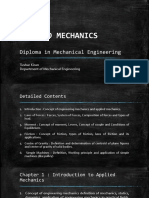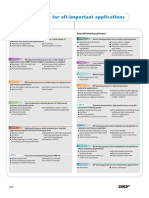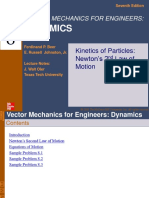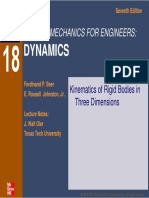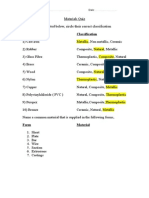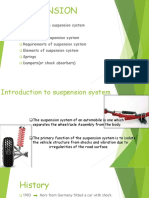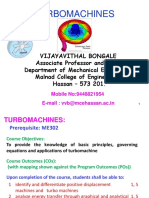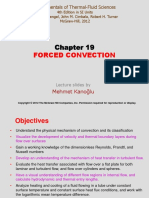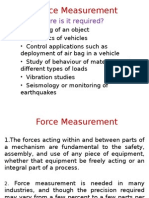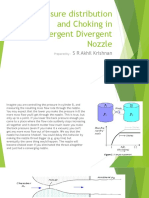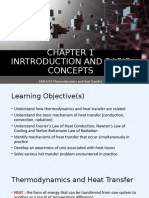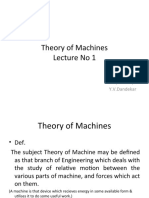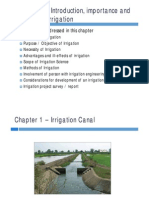0 ratings0% found this document useful (0 votes)
97 viewsMoment of Inertia
Moment of Inertia
Uploaded by
Hasanur Rahman MishuThe document discusses several topics related to rotational motion including:
1) Moment of inertia and how it is calculated for different objects using integrals, with examples such as a cylinder.
2) The parallel axis theorem which states that the moment of inertia of a body rotating around an arbitrary axis is equal to the moment of inertia around a parallel axis through the center of mass plus the mass times the perpendicular distance squared.
3) Examples of calculating kinetic energy of rotating objects using the equation K=0.5*I*ω^2 and applications such as flywheels for energy storage.
4) Concepts of torque as the "force" of rotation and examples of calculating torque using lever arms and forces
Copyright:
Attribution Non-Commercial (BY-NC)
Available Formats
Download as PDF, TXT or read online from Scribd
Moment of Inertia
Moment of Inertia
Uploaded by
Hasanur Rahman Mishu0 ratings0% found this document useful (0 votes)
97 views33 pagesThe document discusses several topics related to rotational motion including:
1) Moment of inertia and how it is calculated for different objects using integrals, with examples such as a cylinder.
2) The parallel axis theorem which states that the moment of inertia of a body rotating around an arbitrary axis is equal to the moment of inertia around a parallel axis through the center of mass plus the mass times the perpendicular distance squared.
3) Examples of calculating kinetic energy of rotating objects using the equation K=0.5*I*ω^2 and applications such as flywheels for energy storage.
4) Concepts of torque as the "force" of rotation and examples of calculating torque using lever arms and forces
Original Description:
Moment of inertia Basics
Copyright
© Attribution Non-Commercial (BY-NC)
Available Formats
PDF, TXT or read online from Scribd
Share this document
Did you find this document useful?
Is this content inappropriate?
The document discusses several topics related to rotational motion including:
1) Moment of inertia and how it is calculated for different objects using integrals, with examples such as a cylinder.
2) The parallel axis theorem which states that the moment of inertia of a body rotating around an arbitrary axis is equal to the moment of inertia around a parallel axis through the center of mass plus the mass times the perpendicular distance squared.
3) Examples of calculating kinetic energy of rotating objects using the equation K=0.5*I*ω^2 and applications such as flywheels for energy storage.
4) Concepts of torque as the "force" of rotation and examples of calculating torque using lever arms and forces
Copyright:
Attribution Non-Commercial (BY-NC)
Available Formats
Download as PDF, TXT or read online from Scribd
Download as pdf or txt
0 ratings0% found this document useful (0 votes)
97 views33 pagesMoment of Inertia
Moment of Inertia
Uploaded by
Hasanur Rahman MishuThe document discusses several topics related to rotational motion including:
1) Moment of inertia and how it is calculated for different objects using integrals, with examples such as a cylinder.
2) The parallel axis theorem which states that the moment of inertia of a body rotating around an arbitrary axis is equal to the moment of inertia around a parallel axis through the center of mass plus the mass times the perpendicular distance squared.
3) Examples of calculating kinetic energy of rotating objects using the equation K=0.5*I*ω^2 and applications such as flywheels for energy storage.
4) Concepts of torque as the "force" of rotation and examples of calculating torque using lever arms and forces
Copyright:
Attribution Non-Commercial (BY-NC)
Available Formats
Download as PDF, TXT or read online from Scribd
Download as pdf or txt
You are on page 1of 33
Rotation
Moment of inertia of a rotating body:
I = r
2
dm
w
Usually reasonably easy to calculate when
Body has symmetries
Rotation axis goes through Center of mass
Exams: All moment of inertia will be given!
No need to copy the table from the book.
Rotation
Parallel axis theorem:
Assume the body rotates
around an axis through P.
.
COM
.
P
dm
Let the COM be the center
of our coordinate system.
P has the coordinates (a,b)
a
b
I = r
2
dm = (x-a)
2
+(y-b)
2
dm
= (x
2
+y
2
)dm 2a xdm 2b ydm + (a
2
+b
2
) dm
= I
COM
0 0 + h
2
M
I = I
COM
+ h
2
M This is something you might need
w w
w w w w
Rotation
Parallel axis theorem:
Assume the body rotates
around an axis through P.
.
COM
.
P
dm
Let the COM be the center
of our coordinate system.
P has the coordinates (a,b)
a
b
I = I
COM
+Mh
2
The moment of inertia of a body rotating around an
arbitrary axis is equal to the moment of inertia of a body
rotating around a parallel axis through the center of mass
plus the mass times the perpendicular distance between the
axes h squared.
36kg
9kg
4kg
h=1m
h=2m
h=3m
If R<<h I
COM
<<< Mh
2
All have essentially the same
moment of inertia:
I ~ 36 kg m
2
Solid sphere of radius R rotating
around symmetry axis: I = 2MR
2
/5
Example: Moment of inertia
I = I
COM
+Mh
2
I
COM,A
>
I
COM,B
>
I
COM,C
Example: Moment of inertia
.
P
I = r
2
dm
w
Step1: Replace dm with an integration
over a volume element dV.
Step 2: Express the volume element in
useful coordinates and find the boundaries
for the integration.
Step 3: Integrate
Lets calculate the moment of inertia for
an annular homogeneous cylinder rotating
around the central axis:
Parameters: Mass M, Length L
Outer and Inner Radii R
1
, R
2
Example: Moment of inertia
.
P
I = r
2
dm
w
Step1: Replace dm with an integration
over a volume element dV.
Homogeneous:
Density p = M/V dm = p dV
and p is independent of the coordinates
(As long as we only integrate over the body
itself and not over empty space)
I =p r
2
dV
w
Lets calculate the moment of inertia for
an annular homogeneous cylinder rotating
around the central axis:
Parameters: Mass M, Length L
Outer and Inner Radii R
1
, R
2
V
cyl
= r L (R
1
2
-R
2
2
)
Example: Moment of inertia
.
P
Step 2: Express the volume element in
useful coordinates and find the boundaries
for the integration.
I =p r
2
dV
dV = dxdydz in cartesian coordinates
Better coordinates:
cylindrical coordinates
w
ds
dr
x
y
Lets calculate the moment of inertia for
an annular homogeneous cylinder rotating
around the central axis:
Parameters: Mass M, Length L
Outer and Inner Radii R
1
, R
2
Volume element in cylindrical coordinates
I =p r
2
dV
dV = dxdydz in cartesian coordinates
Better coordinates for this problem:
Cylindrical Coordinates
dz is the same in both
only change how we
describe things in the
x-y plane
w
ds
dr
x
y
Area element in x-y plane
dsdr = rdodr
dV = dxdydz = rdodrdz
Example: Moment of inertia
.
P
Step 2: Express the volume element in
useful coordinates and find the boundaries
for the integration.
I =p r
2
dV
I =p r
2
rdodrdz
I =p L 2r (R
1
4
-R
2
4
)/4 Use (R
1
4
-R
2
4
) = (R
1
2
+R
2
2
) (R
1
2
-R
2
2
)
I = M (R
1
2
+R
2
2
)/2 See Table in book, also Sample Problem 10-7
w
w
Integration boundaries:
z: -L/2 to L/2, o: 0 to 2r
r: R
2
to R
1
z-integration
o-integration
r-integration
Recall: V
cyl
= r L (R
1
2
-R
2
2
)
Kinetic Energy
Kinetic energy of a rotating body:
Lets split up the body into a collection of particles
.
r
i Rotational Inertia:
I = (Lm
i
r
i
2
)
K = 0.5 (Lm
i
r
i
2
) u
2
K = 0.5 I u
2
Compare with translation:
K = 0.5 m v
2
Correspondences:
v <-> u
I <-> m
v
m
Example: Kinetic Energy
Energy storage in an electric flywheel:
K
rot
= 0.5 I u
2
http://en.wikipedia.org/wiki/Flywheel#Physics
To reduce mass w/o reducing I
it might be useful to use an
annular cylinder.
But material stress favors
solid wheels for high end
applications.
Example: Kinetic Energy
Energy storage in an electric flywheel:
K
rot
= 0.5 I u
2
Example (solid wheel):
M = 600kg, R=0.5m
I = 75kg m
2
Rotates 30000rpm:
f = 30000rpm/60s/min = 500Hz
u = 2rf = r * 1000 rad/s
K
rot
= 370MJ
A lot of energy which can be released very fast in
fusion reactors, in braking systems used in trains etc.
Torque
We have
discussed the equations describing the
dynamical variables of rotation (u, u, o)
calculated the kinetic energy associated
with a rotating body
pointed out the similarities with translations
What is missing: The 'force' of rotation, the torque
Note: Nm = J but J is only used for energies and Nm only for torques
Example
3L/4
.
Pivot Point
L/4
F
What is the angular acceleration?
Use o = t/I need to get I and t
Moment of inertia: I = I
com
+M(L/4)
2
= ML
2
/12+ML
2
/16
I = 7ML
2
/48
Torque: t = F L/4 (Note F is perpendicular to lever arm)
o = t/I = (FL/ML
2
) (48/(7*4)) = 12 * F/(7*M*L)
Example
3L/4
.
Pivot Point
L/4
F
1
Assume a second force is now applied at the other end
of the stick. What would be its magnitude and direction
if it prevents the stick from rotating?
No rotation: t
Net
= 0 t
1
= F
1
L/4 = t
2
= F
2
3L/4
Direction of the force will be the same (both down)
Magnitude: F
2
=F
1
/3
F
2
Example
A uniform disk with mass M = 2.5kg
and radius R=20cm is mounted on a
horizontal axle. A block of mass
m=1.2kg hangs from a massless
cord that is wrapped around the rim
of the disk.
Q1:
Find the acceleration of the falling block.
.
Notice:
We have two forces acting on mass m:
Gravity and tension from the string
We have one torque caused by the
tension in the string acting on the disk
The linear motion of the mass is linked to the
circular motion of the disk via the cord.
Example
A uniform disk with mass M = 2.5kg
and radius R=20cm is mounted on a
horizontal axle. A block of mass
m=1.2kg hangs from a massless
cord that is wrapped around the rim
of the disk.
Q1:
Find the acceleration of the falling block.
.
Notice:
We have two forces acting on mass m:
Gravity and tension from the string
ma = T-mg (equation of motion of the falling block)
(Unknowns: a and T)
Example
A uniform disk with mass M = 2.5kg
and radius R=20cm is mounted on a
horizontal axle. A block of mass
m=1.2kg hangs from a massless
cord that is wrapped around the rim
of the disk.
Q1:
Find the acceleration of the falling block.
.
Notice:
We have one torque caused by the
tension in the string acting on the disk
t = -TR (force T perpendicular to lever arm
negative, because of clockwise rotation)
= Io =0.5 MR
2
o T = -0.5MRo
Example
A uniform disk with mass M = 2.5kg
and radius R=20cm is mounted on a
horizontal axle. A block of mass
m=1.2kg hangs from a massless
cord that is wrapped around the rim
of the disk.
Q1:
Find the acceleration of the falling block.
.
Notice:
ma = T-mg and T = -0.5MRo
The linear motion of the mass is linked to the
circular motion of the disk via the cord.
a = Ro 3 equations, 3 unknowns: T, a, o
Example
A uniform disk with mass M = 2.5kg
and radius R=20cm is mounted on a
horizontal axle. A block of mass
m=1.2kg hangs from a massless
cord that is wrapped around the rim
of the disk.
ma = T-mg, T = -0.5MRo, a = Ro
.
Some math:
ma = -0.5Ma mg a = -2mg/(M+2m) = -4.8m/s
2
Angular accel.: o = a/R = -4.8/0.2rad/s
2
= -24rad/s
2
Tension in the cord: T = -0.5MRo = 6.0N
Check out Table 10.3
for analogy with translation
Work and kinetic Energy
y
x
Rod
r
F
F
r
F
t
The radial component of F does not do any work
as it does not displace the mass m
The tangential component of F does displace the
mass by ds and does work:
dW = F
t
ds = F
t
rdu = tdu
m
Work and kinetic Energy
W= dW = t du = t (u
f
u
i
) Work done
during displacement
w
w
u
f
u
i
for constant torque
Recall Work for constant force and translation:
W= dW = Fdx = F(x
f
-x
i
)
w
x
i
x
f
Power: P=dW/dt = tu (rotation about fixed axis)
Work and kinetic Energy
y
x
Rod
r
F
F
r
F
t
The tangential component of F does increase the velocity
of the mass:
K
f
-K
i
= 0.5mv
f
2
-0.5mv
i
2
=W
use v=ur K
f
-K
i
= 0.5mr
2
u
f
2
-0.5mr
2
u
i
2
K
f
-K
i
= 0.5Iu
f
2
-0.5Iu
i
2
=W
m
Work and kinetic Energy
y
x
Rod
r
F
F
r
F
t
m
If we assume that the particle is part of a solid body
then we would have to repeat this for all particles in
the body. Adding up all these changes in kinetic energy
and the work would show that this also works for a solid
body.
We just derived the
relation between
work done by
a net torque and the
change in kinetic
energy for a
single particle.
Work and kinetic Energy
Problem 66.
m=0.6kg
r = 0.05m
I = 0.003kgm
2
M=4.5kg
h
Q: What is the velocity of
mass m after it dropped a
distance h? (No friction)
mg
Work and kinetic Energy
Problem 66.
m=0.6kg
r = 0.05m
I = 0.003kgm
2
M=4.5kg
h
Q: What is the velocity of
mass m after it dropped a
distance h? (No friction)
Two possible approaches:
a) Use forces (gravity and tension) and torques
b) Energy conservation
mg
Work and kinetic Energy
Problem 66.
m=0.6kg
r = 0.05m
I = 0.003kgm
2
spherical shell
of M=4.5kg
h
b) Energy conservation
As we are only interested in the
situation at the end and energy
is conserved, this should work.
mg
Initial: U=mgh, Final: K
shell
+ K
pulley
+ K
mass
Work and kinetic Energy
Problem 66.
m=0.6kg
r = 0.05m
I = 0.003kgm
2
spherical shell
of M=4.5kg
h
mg
Initial: U=mgh,
Final: K
shell
=0.5I
S
u
S
2
=0.5(2MR
2
/3)u
S
2
K
pulley
= 0.5I
p
u
P
2
K
mass
= 0.5mv
2
Also know that the 'length of the string is conserved':
v=u
P
r, v=u
S
R Use this to replace the u's in the kinetic energies
mgh = Mv
2
/3 + 0.5I
p
v
2
/r
2
+ 0.5mv
2
Solve for v = 1.4m/s
You might also like
- 111 How Power Plants Work Course DescriptionDocument1 page111 How Power Plants Work Course DescriptionAnonymous q9eCZHMuSNo ratings yet
- Chapter 1 - Gas LawDocument52 pagesChapter 1 - Gas LawLolindah ChinNo ratings yet
- DR KC Yadav, Director, Jindal Institute of Power TechnologyDocument75 pagesDR KC Yadav, Director, Jindal Institute of Power TechnologyPrudhvi RajNo ratings yet
- Applied Mechanics CH 1Document11 pagesApplied Mechanics CH 1Tushar KiranNo ratings yet
- Marshall Mix DesignDocument3 pagesMarshall Mix DesignHasanur Rahman Mishu33% (3)
- Rigid Body DynamicsDocument55 pagesRigid Body DynamicsKenn ConsueloNo ratings yet
- Vector Mechanics For Engineers: Dynamics: Twelfth EditionDocument47 pagesVector Mechanics For Engineers: Dynamics: Twelfth EditionFady MagedNo ratings yet
- Fracture - Material TechnologyDocument18 pagesFracture - Material TechnologyayushdbcNo ratings yet
- SKF GreaseDocument3 pagesSKF GreaseKumar SwamiNo ratings yet
- Chapter 8 - Kinetics of Particles - Newton's 2nd Law of MotionDocument14 pagesChapter 8 - Kinetics of Particles - Newton's 2nd Law of MotionrushdiNo ratings yet
- Operator S Guide To General Purpose Steam Turbines - 2016 - PerezDocument27 pagesOperator S Guide To General Purpose Steam Turbines - 2016 - Perezmanashi.barik.2019No ratings yet
- Unit-II-IC Engines-Lecture 1-IntroductionDocument47 pagesUnit-II-IC Engines-Lecture 1-IntroductionarulNo ratings yet
- Characteristic of Laminar FlowDocument1 pageCharacteristic of Laminar FlowMohd Hafiz Ahmad100% (3)
- Planar Kinetics of A Rigid Body: Work & EnergyDocument25 pagesPlanar Kinetics of A Rigid Body: Work & EnergyZoker_45No ratings yet
- Unit 5: Hydro Electric Power PlantDocument33 pagesUnit 5: Hydro Electric Power PlantSavant100% (2)
- 7 Force AnalysisDocument19 pages7 Force AnalysisEn Eskay50% (2)
- Mech Vibration Intro - RahulDocument36 pagesMech Vibration Intro - Rahulrs100788No ratings yet
- MS - 57 SolvedDocument8 pagesMS - 57 Solvedprajwolrajaryal4980No ratings yet
- Thermodynamic CyclesDocument25 pagesThermodynamic CyclesMoonsoul ChildNo ratings yet
- Turbo Machinery Course OutlineDocument4 pagesTurbo Machinery Course OutlineLeul SolomonNo ratings yet
- Physics Formula SheetDocument4 pagesPhysics Formula SheetAbderrafie BCNo ratings yet
- Air CompressorsDocument57 pagesAir Compressorssgupta_615796No ratings yet
- Design and Proposal of Solar Photovoltaic Power Plant For Medium Scale IndustryDocument12 pagesDesign and Proposal of Solar Photovoltaic Power Plant For Medium Scale Industrykartik kapoorNo ratings yet
- CHAP18 Kinematics of Rigid Bodies in 3DDocument31 pagesCHAP18 Kinematics of Rigid Bodies in 3DMurat Hamza SARINo ratings yet
- Revision Questions On Simple Harmonic MotionDocument5 pagesRevision Questions On Simple Harmonic MotionAnoop BrgNo ratings yet
- VIBRATION & WAVE. TOPIC 1pptm PDFDocument36 pagesVIBRATION & WAVE. TOPIC 1pptm PDFMirahmad FadzlyNo ratings yet
- Ferrite Processing: Powder Preparation-Raw Materials SelectionDocument66 pagesFerrite Processing: Powder Preparation-Raw Materials Selection吳尚謙No ratings yet
- Materials Quiz and Properties AnswersDocument3 pagesMaterials Quiz and Properties AnswersSamantha AshmanNo ratings yet
- Applied Mech Meng 223Document83 pagesApplied Mech Meng 223ABUBAKARR BANGURANo ratings yet
- Chapter 5 Belt and Rope Drives Mrs. Noor HDocument12 pagesChapter 5 Belt and Rope Drives Mrs. Noor HfdsfsdfsdfsfsNo ratings yet
- Basic ThermodynamicDocument55 pagesBasic ThermodynamicSumiran ManghaniNo ratings yet
- Turbo MachinesDocument11 pagesTurbo Machinesratchagaraja100% (1)
- 002general Energy Analysis of THERMODYNAMICSDocument30 pages002general Energy Analysis of THERMODYNAMICSm7sen mohammedNo ratings yet
- Chapter 9Document37 pagesChapter 9Nebiyou KorraNo ratings yet
- Diff Types of Suspension Used in Automotive Industriesss PDFDocument26 pagesDiff Types of Suspension Used in Automotive Industriesss PDFRahul SharmaNo ratings yet
- The Zeroth and First Law of ThermodynamicsDocument7 pagesThe Zeroth and First Law of Thermodynamicsdennie85100% (1)
- Practice Assignment Work Energy and PowerDocument3 pagesPractice Assignment Work Energy and PowerAyush GogiaNo ratings yet
- Optim NotesDocument19 pagesOptim NotesDipteemaya BiswalNo ratings yet
- Turbomachines Intro 1Document22 pagesTurbomachines Intro 1Mukul Goyal0% (1)
- MIMO Control (Multiple Input Multiple Output)Document17 pagesMIMO Control (Multiple Input Multiple Output)Sohail Aziz Ahmad MalikNo ratings yet
- Dynamics - Chapter 16 (Beer7)Document39 pagesDynamics - Chapter 16 (Beer7)api-3709496100% (4)
- 11 SplitRange&SelectiveControl PDFDocument6 pages11 SplitRange&SelectiveControl PDFLinh ThùyNo ratings yet
- 113 Using Steam in The Power Plant Course PreviewDocument19 pages113 Using Steam in The Power Plant Course PreviewAnonymous q9eCZHMuS100% (1)
- Mechatronics Application and System DesignDocument10 pagesMechatronics Application and System Designswap1983No ratings yet
- 9259478Document64 pages9259478Brajesh Kumar100% (1)
- Optimization NonlinearDocument144 pagesOptimization NonlinearKrystal GamboaNo ratings yet
- Force MeasurementDocument57 pagesForce MeasurementmeghanaNo ratings yet
- 05 Time Response AnalysisDocument41 pages05 Time Response AnalysisFadly ShafiqNo ratings yet
- Pressure Distribution and Choking in Convergent Divergent NozzleDocument6 pagesPressure Distribution and Choking in Convergent Divergent NozzleS R Akhil KrishnanNo ratings yet
- Introduction and Basic ConceptDocument41 pagesIntroduction and Basic ConceptSin Ye PhoonNo ratings yet
- Damped Simple Harmonic MotionDocument15 pagesDamped Simple Harmonic MotionIoannis GaroufalidisNo ratings yet
- Internal EnergyDocument7 pagesInternal EnergyApurva WalunjNo ratings yet
- PE 4030chapter 1 Mechatronics 9 23 2013 Rev 1.0Document76 pagesPE 4030chapter 1 Mechatronics 9 23 2013 Rev 1.0Charlton S.InaoNo ratings yet
- Lecture 1. Introduction To Solution ThermodynamicsDocument26 pagesLecture 1. Introduction To Solution ThermodynamicsHan VendiolaNo ratings yet
- Waves DampingDocument19 pagesWaves DampingjemwesleyNo ratings yet
- Theory of MachinesDocument6 pagesTheory of MachinesYogesh DandekarNo ratings yet
- Proximate AnalysisDocument5 pagesProximate Analysisshba_duqueNo ratings yet
- Combustion Control For BoilersDocument26 pagesCombustion Control For Boilersrashmikothlikar100% (1)
- M Bayu Irpan F 4EBDocument5 pagesM Bayu Irpan F 4EBBayu Jarai100% (1)
- Chap 10Document63 pagesChap 10sidiquesoomro19No ratings yet
- Consumptive Use of IrrigationDocument102 pagesConsumptive Use of IrrigationHasanur Rahman Mishu100% (1)
- 6664 01 Que 20130114Document32 pages6664 01 Que 20130114ZǻïȠŸ ÅðNo ratings yet
- Irrigation - Definition and MethodsDocument87 pagesIrrigation - Definition and MethodsHasanur Rahman MishuNo ratings yet
- Basic Features of CDocument16 pagesBasic Features of CHasanur Rahman MishuNo ratings yet
- Media and Globalization: What Is The Media's Influence?Document10 pagesMedia and Globalization: What Is The Media's Influence?Hasanur Rahman MishuNo ratings yet
- Early Thinker of SociologyDocument6 pagesEarly Thinker of SociologyHasanur Rahman MishuNo ratings yet
- PlasteringDocument29 pagesPlasteringHasanur Rahman MishuNo ratings yet



